
Quantico is a town in Prince William County, Virginia, United States. The population was 480 at the 2010 census. Quantico is approximately 35 miles southwest of Washington, D.C., bordered by the Potomac River to the east and the Quantico Creek to the north. The word Quantico is a corruption of the name of a Doeg village recorded by English colonists as Pamacocack.

Marine Corps Base Quantico is a United States Marine Corps installation located near Triangle, Virginia, covering nearly 55,148 acres of southern Prince William County, Virginia, northern Stafford County, and southeastern Fauquier County. Used primarily for training purposes, MCB Quantico is known as the "Crossroads of the Marine Corps".

Christian Frank Schilt was an American general in the U.S. Marine Corps. He was one of the first Marine Corps aviators and a recipient of the United States highest military decoration, the Medal of Honor. He received the Medal for using his biplane to evacuate wounded Marines under fire in Nicaragua.
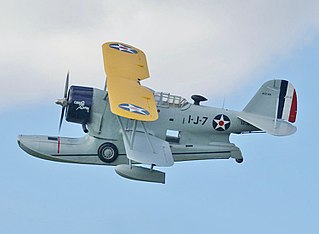
The Grumman J2F Duck is an American single-engine amphibious biplane. It was used by each major branch of the U.S. armed forces from the mid-1930s until just after World War II, primarily for utility and air-sea rescue duties. It was also used by the Argentine Navy, who took delivery of their first example in 1937. After the war, J2F Ducks saw service with independent civilian operators, as well as the armed forces of Colombia and Mexico.

The Boeing P-12 or Boeing F4B is an American pursuit aircraft that was operated by the United States Army Air Corps, United States Marine Corps, and United States Navy. It was the chief fighter aircraft in American service during the early 1930s but also used internationally. By the late 1930s it was replaced in front-line duty by newer designs, but it was still used for training into the early 1940s. Many variants of the aircraft were developed. In the 21st century a handful of surviving air frames are on display in museums.
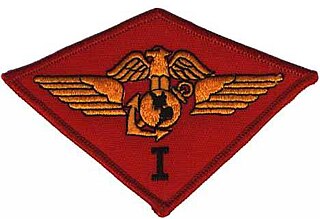
The 1st Marine Aircraft Wing is an aviation unit of the United States Marine Corps that serves as the Aviation Combat Element of the III Marine Expeditionary Force. The wing is headquartered at Camp Foster on the island of Okinawa, Japan. Activated in 1940, the wing has seen heavy combat operations during World War II, the Korean War, and the Vietnam War.

Marine Aircraft Group 11 is a United States Marine Corps aviation unit based at Marine Corps Air Station Miramar that is currently composed of two F-35C squadrons, one F-35B squadron, two F/A-18C squadrons, one fleet replacement squadron, one KC-130J tactical aerial refueling squadron, a maintenance and logistics squadron, and a wing support squadron. They fall under the command of the 3rd Marine Aircraft Wing and the I Marine Expeditionary Force.

Marine Aviation Logistics Squadron 11 (MALS-11) is an aviation logistics support unit of the United States Marine Corps, part of Marine Aircraft Group 11 (MAG-11), currently based at Marine Corps Air Station Miramar and also part of the 3rd Marine Aircraft Wing.

Marine Aircraft Group 24 (MAG-24) is a United States Marine Corps aviation unit based at Marine Corps Air Station Kaneohe Bay. MAG-24 is subordinate to the 1st Marine Aircraft Wing and the III Marine Expeditionary Force.
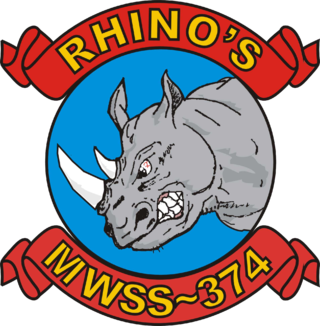
Marine Wing Support Squadron 374 was an aviation ground support unit of the United States Marine Corps. They were based out of Marine Corps Air Ground Combat Center Twentynine Palms, California. The squadron was part of Marine Wing Support Group 37 and the 3rd Marine Aircraft Wing. MWSS-374 was officially deactivated, 31 March 2022, at Marine Corp Air Ground Combat Center,(MCAGCC) 29 Palms,Ca. during a Sunset Ceremony.

Marine Wing Support Squadron 372 is an aviation ground support unit of the United States Marine Corps. Known as the "Diamondbacks", the squadron is based at Marine Corps Base Camp Pendleton, California. It falls under the command of Marine Air Control Group 38 and the 3rd Marine Aircraft Wing and maintains a direct support relationship to Marine Aircraft Group 39.

Marine Air Control Squadron 1 (MACS-1) is a United States Marine Corps aviation command and control squadron. The squadron provides aerial surveillance, air traffic control, ground-controlled intercept, and aviation data-link connectivity for the I Marine Expeditionary Force. It was the first air warning squadron commissioned as part of the Marine Corps' new air warning program and is the second oldest aviation command and control unit in the Marine Corps. The squadron is based at Marine Corps Air Station Yuma and falls under Marine Air Control Group 38 and the 3rd Marine Aircraft Wing.

Marine Air Control Squadron 2 (MACS-2) is a United States Marine Corps aviation command and control squadron. The squadron provides aerial surveillance, Ground-controlled interception, and air traffic control for the II Marine Expeditionary Force. They are based at Marine Corps Air Station Cherry Point and fall under Marine Air Control Group 28 and the 2nd Marine Aircraft Wing.

The United States Marine Corps Aviation (USMCA) is the aircraft arm of the United States Marine Corps. Aviation units within the Marine Corps are assigned to support the Marine Air-Ground Task Force, as the aviation combat element, by providing six functions: assault support, antiair warfare, close air support, electronic warfare, control of aircraft and missiles, and aerial reconnaissance. The Corps operates rotary-wing, tiltrotor, and fixed-wing aircraft mainly to provide transport and close air support to its ground forces. Other aircraft types are also used in a variety of support and special-purpose roles. All Marine Corps aviation falls under the influence of the Deputy Commandant for Aviation, whose job is to advise the Commandant of the Marine Corps in all matters relating to aviation, especially acquisition of new assets, conversions of current aircraft, maintenance, operation, and command.
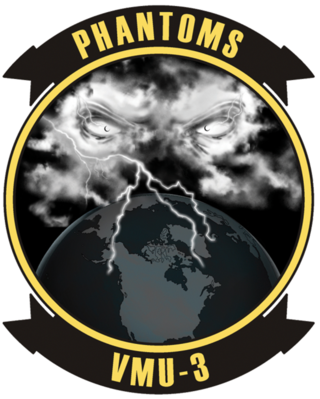
Marine Unmanned Aerial Vehicle Squadron 3 is an unmanned aerial vehicle (UAV) squadron in the United States Marine Corps that operates the MQ-9A Reaper that consists of approximately 200 Marines. They are based out of Marine Corps Base Hawaii, Kaneohe Bay, Hawaii and its primary mission is to provide aerial surveillance for the III Marine Expeditionary Force. The unit also provides Reconnaissance, Surveillance, and Target Acquisition (RSTA) to units participating in Mojave Viper, an exercise held several times a year in 29 Palms, CA. The squadron, nicknamed the Phantoms, was activated on 12 September 2008 and falls under the command of Marine Aircraft Group 24 and the 1st Marine Aircraft Wing.
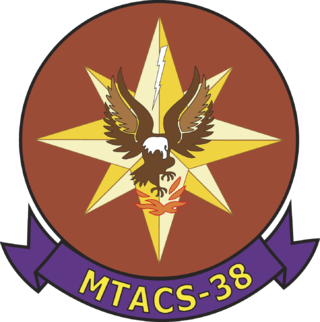
Marine Tactical Air Command Squadron 38 (MTACS-38) was a United States Marine Corps aviation command and control unit that provided the Tactical Air Command Center (TACC) for the 3rd Marine Aircraft Wing. The TACC is the senior agency in the Marine Air Command and Control System (MACCS) and serves as the operational command post for the commander of the aviation combat element and their staff. The squadron was based at Marine Corps Air Station Miramar, California and fell under the command of Marine Air Control Group 38 and the 3rd Marine Aircraft Wing.

Edward Colston Dyer was a brigadier general in the United States Marine Corps who served in both World War II and the Korean War. A naval aviator and communications engineer, during his career he was a pioneer in the Marine Corps' development of early warning radar, night fighters, and helicopters.

Homer Spurgeon Hill was a decorated naval aviator in the United States Marine Corps with the rank of major general. A veteran of three wars, Hill began his career as a reservist and pilot of transport planes, participating in combats in Pacific theater.
Marine Air Traffic Control Units (MATCU) were United States Marine Corps air traffic control (ATC) detachments that provided continuous, all-weather, radar and non-radar, approach, departure, enroute, and tower ATC services at both garrison Marine Corps Air Stations and tactical airfields when deployed. MATCUs possessed Tactical air navigation systems (TACAN) and Ground-controlled approach (GCA) equipment which assisted Marine Corps, joint and coalition aircraft in conducting landings during inclement weather. During the Vietnam War, numerous MATCUs served throughout the I Corps Tactical region of South Vietnam supporting the III Marine Amphibious Force. Beginning in the mid-1970s, the Marine Corps decided to consolidate regionally aligned MATCUs into Marine Air Traffic Control Squadrons. The last reserve MATCU was decommissioned in 1980.



















